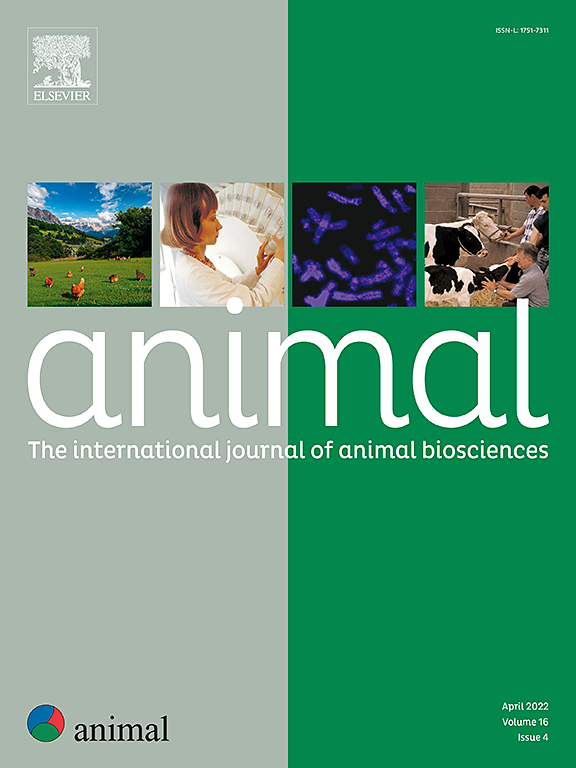全天与半天的母牛-犊牛接触对母牛和犊牛表现的影响
IF 4
2区 农林科学
Q1 AGRICULTURE, DAIRY & ANIMAL SCIENCE
引用次数: 0
摘要
奶牛-犊牛接触系统(CCC)是指奶牛在挤奶的同时对自己的犊牛进行为期数周的哺乳,在动物福利方面具有一些优势。然而,一个主要挑战是挤奶过程中由于吮吸和挤奶问题造成的牛奶损失。减少每日CCC可减少牛奶损失。我们的研究调查了日间半日挤(HC,n = 11 头奶牛)与全日挤(WC,n = 13 头奶牛)和不挤(NC,n = 14 头奶牛)相比,对无精料饲喂的两用牛群的收获奶产量、牛奶含量、乳房健康、产犊间隔和犊牛增重的影响。在 "哺乳"(产后 9 周)之后,母牛和犊牛分离,但仍使用可视 CCC,每天用乳头桶喂两次奶(每天 6 升,"可视/喂奶")。第 11-12 周,犊牛被安置在看不见的地方,并逐渐断奶。NC 小牛在产后 1 天与母亲分离,每天获得 6 升全脂牛奶并逐渐断奶。在 "哺乳 "期间,NC 和 HC 奶牛早上的产奶量高于 WC 奶牛。傍晚,HC 和 WC 的产奶量低于 NC,但 HC 奶牛的产奶量也略低于 WC。在 "哺乳 "期间,脂肪含量降低(-1% 点)表明两种 CCC 处理都存在排乳问题,与白天无关。与犊牛分离后("在视线内/喂奶 "和 "在视线外/断奶 "期间)以及整个泌乳期,HC 和其他处理的产奶量没有显著差异,而 WC 奶牛的产奶量低于 NC 奶牛。母牛的蛋白质含量高于 NC 牛。在乳腺炎发病率、体细胞评分或产犊间隔方面,各处理之间没有迹象表明存在差异。在 "哺乳 "期间,NC犊牛比CCC犊牛每天少增重约0.3公斤(nNC = 12,nHC = 7,nWC = 10)。与母牛分离后,两组 CCC 小牛的生长都受到了影响。在 "观察/喂奶 "期间,HC 的增重低于 NC 和 WC(nNC = 11,nHC = 9,nWC = 10)。此后,体重增长没有差异。断奶两周后,哺乳犊牛的体重仍明显高于 NC(n = 5-8)。与 WC 相比,白天进行九周的 HC 有助于减少哺乳期和整个哺乳期的可售奶损失,而犊牛的发育情况相似。本文章由计算机程序翻译,如有差异,请以英文原文为准。
Effects of whole-day versus half-day cow-calf contact on cows’ and calves’ performance
Cow-calf contact systems (CCCs), where dairy cows nurse their own calves for several weeks while being milked, have some advantages in terms of animal welfare. However, one major challenge is the loss of collected milk due to suckling and milk ejection problems during milking. Reducing daily CCC can decrease milk losses. Our study investigated the effect of half-day CCC during daytime (HC, n = 11 cows) compared to whole-day contact (WC, n = 13) and no contact (NC, n = 14) on harvested milk yield, milk content, udder health, calving interval, and calf weight gain in a dual purpose breed-herd with concentrate-free feeding. ‘Nursing’ (9 weeks postpartum) was followed by separation of cow and calf, but still with visual CCC and twice daily milk feeding by nipple buckets (6 l per day, ‘in sight/milk feeding’). During the 11th–12th week, calves were housed out of sight and gradually weaned. Calves of NC were separated from their mothers 1 day postpartum, obtained 6 l whole-milk per day and were gradually weaned. During ‘nursing’, NC and HC cows gave more milk than WC in the morning. In the evening, HC and WC gave less milk than NC, but HC cows had also a slightly lower milk yield than WC. During ‘nursing’, a reduced fat content (−1% point) pointed at milk ejection problems in both CCC treatments independent from daytime. After separation from the calf (periods: ‘in sight/milk feeding’ and ‘out of sight/weaning’) and over the whole lactation, milk yield between HC and the other treatments did not significantly differ while WC cows gave less milk than NC cows. Protein contents were higher in dams than in NC. There were no indications of differences in the incidence of mastitis, somatic cell score or calving interval between treatments. During ‘nursing’, NC calves gained about 0.3 kg less per day than CCC-calves (nNC = 12, nHC = 7, nWC = 10). After separation from the mother, there was a growth check in both CCC groups. During ‘in sight/milk feeding’, HC gained less weight than NC and WC (nNC = 11, nHC = 9, nWC = 10). Hereafter, weight development did not differ. Two weeks after weaning, nursed calves were still significantly heavier than NC (n = 5–8). Nine weeks of HC during the day compared to WC helped to reduce losses of sellable milk during the nursing period and over the whole lactation while calf development was similar.
求助全文
通过发布文献求助,成功后即可免费获取论文全文。
去求助
来源期刊

Animal
农林科学-奶制品与动物科学
CiteScore
7.50
自引率
2.80%
发文量
246
审稿时长
3 months
期刊介绍:
Editorial board
animal attracts the best research in animal biology and animal systems from across the spectrum of the agricultural, biomedical, and environmental sciences. It is the central element in an exciting collaboration between the British Society of Animal Science (BSAS), Institut National de la Recherche Agronomique (INRA) and the European Federation of Animal Science (EAAP) and represents a merging of three scientific journals: Animal Science; Animal Research; Reproduction, Nutrition, Development. animal publishes original cutting-edge research, ''hot'' topics and horizon-scanning reviews on animal-related aspects of the life sciences at the molecular, cellular, organ, whole animal and production system levels. The main subject areas include: breeding and genetics; nutrition; physiology and functional biology of systems; behaviour, health and welfare; farming systems, environmental impact and climate change; product quality, human health and well-being. Animal models and papers dealing with the integration of research between these topics and their impact on the environment and people are particularly welcome.
 求助内容:
求助内容: 应助结果提醒方式:
应助结果提醒方式:


